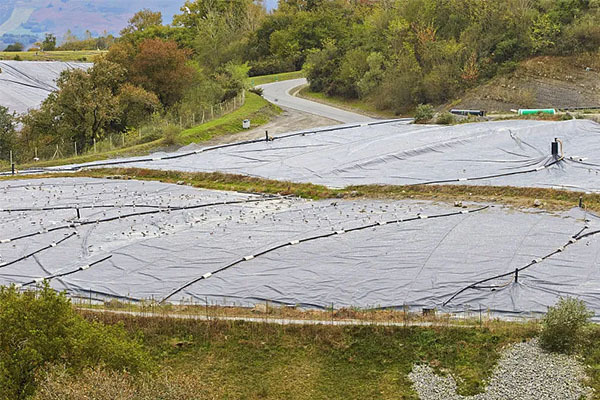Exploring the Advantages of Warp-Knitted Geogrids in Construction
Release time:
2025-06-12
Exploring the Advantages of Warp-Knitted Geogrids in Construction Table of Contents 1. Introduction to Warp-Knitted Geogrids 2. What Are Geogrids? 3. Benefits of Warp-Knitted Geogrids 3.1 Enhanced Soil Stability 3.2 Cost-Effectiveness 3.3 Lightweight Design 3.4 Long-term Durability 4. Applications in Construction 4.1 Road and Bridge Constructio
Exploring the Advantages of Warp-Knitted Geogrids in Construction
Table of Contents
- 1. Introduction to Warp-Knitted Geogrids
- 2. What Are Geogrids?
- 3. Benefits of Warp-Knitted Geogrids
- 4. Applications in Construction
- 5. Comparison with Other Geogrids
- 6. Sustainability and Environmental Impact
- 7. Installation and Maintenance
- 8. FAQs about Warp-Knitted Geogrids
- 9. Conclusion
1. Introduction to Warp-Knitted Geogrids
In the construction industry, the choice of materials significantly impacts the overall quality and durability of a project. **Warp-knitted geogrids** are emerging as a top choice for many applications due to their robust design and versatile functionality. These innovative materials are engineered specifically to provide enhanced ground stability and support, making them indispensable in modern construction practices.
2. What Are Geogrids?
Geogrids are planar, geosynthetic materials that are used to reinforce soil and other geotechnical structures. They come in various configurations, including uniaxial, biaxial, and warp-knitted forms. Warp-knitted geogrids are particularly notable for their unique manufacturing process, which involves interlacing yarns to create a stable, grid-like structure that offers superior load distribution and soil interaction.
3. Benefits of Warp-Knitted Geogrids
The benefits of warp-knitted geogrids in construction are numerous. Below, we delve into some of the key advantages they offer:
3.1 Enhanced Soil Stability
One of the primary benefits of warp-knitted geogrids is their ability to enhance soil stability. By providing a matrix for soil to interlock, they significantly reduce the risk of soil deformation and failure. This stability is crucial in applications such as foundations, retaining walls, and road construction, where uneven settling can lead to structural issues.
3.2 Cost-Effectiveness
Warp-knitted geogrids also contribute to cost savings in construction projects. Their lightweight nature reduces transportation and installation costs. Additionally, the long-term stability they offer can minimize the need for repairs or reinforcements, resulting in lower overall project costs.
3.3 Lightweight Design
The lightweight design of warp-knitted geogrids allows for easy handling and installation. This factor not only speeds up the construction process but also reduces the need for heavy machinery, further lowering project expenses. Their strength-to-weight ratio makes them an ideal choice for various geotechnical applications.
3.4 Long-term Durability
Durability is a critical concern in construction materials. Warp-knitted geogrids are designed to withstand harsh environmental conditions, including moisture, heat, and soil chemicals. Their resistance to degradation ensures that they maintain structural integrity over extended periods, making them a reliable choice for long-term projects.
4. Applications in Construction
Warp-knitted geogrids have a wide range of applications in the construction industry. Their versatility makes them suitable for various projects, including:
4.1 Road and Bridge Construction
In road and bridge construction, warp-knitted geogrids are used to stabilize the subbase and subgrade layers. By distributing loads more evenly, they help prevent pavement cracking and extend the lifespan of roadways and bridges.
4.2 Retaining Walls
Warp-knitted geogrids are often employed in the construction of retaining walls. They provide the necessary reinforcement to hold back soil and prevent sliding, ensuring the structural safety and integrity of the wall.
4.3 Landfill Engineering
In landfill engineering, these geogrids play a vital role in supporting the weight of waste materials while preventing subsidence. Their ability to enhance soil stability is crucial for the long-term effectiveness of landfill sites.
5. Comparison with Other Geogrids
When comparing warp-knitted geogrids to other types, such as uniaxial and biaxial geogrids, several distinctions arise. Warp-knitted geogrids typically offer superior strength in multiple directions, providing enhanced performance in applications where multidirectional load support is critical. Their unique construction also allows for better soil interaction, leading to improved stability outcomes compared to traditional geogrids.
6. Sustainability and Environmental Impact
Sustainability is a crucial consideration in modern construction. Warp-knitted geogrids are often made from recyclable materials, contributing to reduced environmental impact. Their durability means that fewer resources are needed for repairs and replacements, further promoting sustainable practices in construction.
7. Installation and Maintenance
The installation process for warp-knitted geogrids is straightforward, requiring minimal specialized equipment. Once installed, these geogrids require little to no maintenance. Their long-lasting nature means that projects utilizing warp-knitted geogrids can enjoy peace of mind, knowing they are built to withstand the test of time.
8. FAQs about Warp-Knitted Geogrids
What materials are warp-knitted geogrids made from?
Warp-knitted geogrids are typically made from high-density polyethylene (HDPE) or polypropylene, providing excellent strength and durability.
How do warp-knitted geogrids compare to traditional geogrids?
Warp-knitted geogrids generally offer better multidirectional strength and improved soil interaction compared to traditional uniaxial or biaxial geogrids.
Are warp-knitted geogrids environmentally friendly?
Yes, many warp-knitted geogrids are made from recyclable materials, making them a sustainable choice for construction projects.
What are the typical applications for warp-knitted geogrids?
Common applications include road and bridge construction, retaining walls, and landfill engineering, among others.
How long do warp-knitted geogrids last?
With proper installation and use, warp-knitted geogrids can last for decades, providing long-term stability and support for various construction projects.
9. Conclusion
Warp-knitted geogrids have emerged as a vital component in the construction industry, offering a range of advantages that enhance soil stability, reduce costs, and promote sustainability. Their lightweight design, durability, and versatility make them suitable for various applications, from road construction to landfill engineering. As the construction landscape continues to evolve, incorporating warp-knitted geogrids into projects not only ensures structural integrity but also aligns with modern sustainable practices. Embracing this innovative material can lead to more efficient and long-lasting construction solutions, paving the way for a brighter future in construction methodologies.
Previous Page






